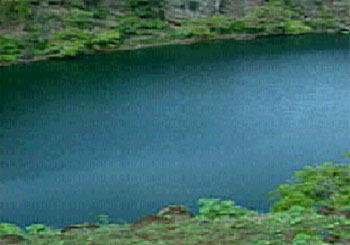Ngazidja, also known as Grand Comore, is the largest island in the Comoro archipelago. Its population of over 234,000 inhabitants is descended from Arab and African ancestors.
Agriculture on the island is generally limited to areas lower than 300 meters (2000ft). Above this altitude are the remnants of a tropical forest in the south, and an area of grassy plain in the center and north. Most Comorian vanilla is grown on Ngazidja.
Two volcanoes form the island's most prominent topographic features: La Grille in the north, with an elevation of 1,000 meters, is extinct and largely eroded; Karthala in the south, rising to a height of 2,361 meters. It erupted more than a dozen times in the last two centuries and last erupted in 2005. Thousands of villagers had to flee. A plateau averaging 600 to 700 meters high connects the two mountains. The capital, Moroni, lies in the shadow of the volcano along the island's west coast. The other main town is Mitsamiouli, an old Shirazi town of 5000 people on the north coast.
The Karthala crater, the world’s largest volcanic crater
The surface of Ngazidja is of hardened lava rock and difficult to drill for water wells. Traditionally, most of Ngazidja's water supply has come from reservoirs filled in the rainy season and from freshwater springs along the coasts (foumbous).There are no perennial streams, and the coast, without large inlets, is not well suited for shipping.
Prince Said Ibrahim International Airport is outside near Moroni. Commercial airlines provide air links with Dubai, Paris, Réunion, and Johannesburg.
For several centuries, Ngazidja was divided into more than a dozen sultanates, including Bambao, Itsandra, Mitsamihuli, Bajini, Hambu, Washili, Hamahame, Mbude, Hamvu and LaDombe. The sultans were also known as falmes. In 1886 the ruler of Bambao, Saidi Ali ibn Saidi Omar, united the sultanates of Grand Comore into the state of Ngazidja, with the other sultanates maintaining autonomy. The same year, France established a protectorate over the island. In 1893 Saidi Ali went into exile. In 1911 France annexed the island and the sultanates were abolished. In 1975 Grand Comore federated with Nzwani/Anjouan and Mwali/ Mohéli to form the nation of Comoros.
In 1997 Nzwani /Anjouan and Mwali /Mohéli seceded, leaving Ngazidja/ Grand Comore the only island under federal control. By 2002, however, Grand Comore was reunited with the other islands under the new constitution of 2001.


